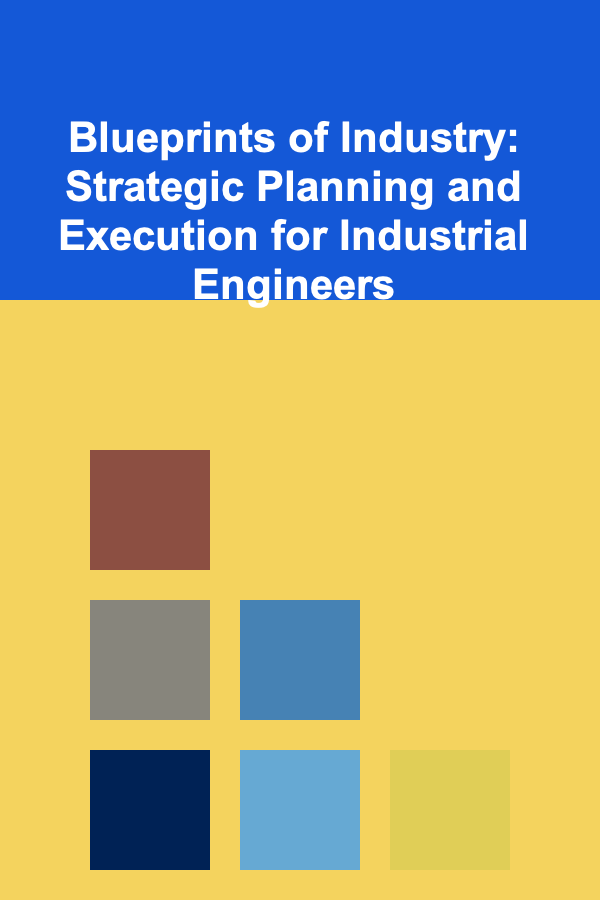
Blueprints of Industry: Strategic Planning and Execution for Industrial Engineers
ebook include PDF & Audio bundle (Micro Guide)
$12.99$9.99
Limited Time Offer! Order within the next:

Industrial engineers are the unsung heroes who optimize systems, processes, and resources in industries that span from manufacturing to services. Their primary role involves improving efficiency, productivity, and quality while reducing costs. To do this effectively, strategic planning and execution are key. This actionable guide will delve into how industrial engineers can approach strategic planning, break down complex systems, and successfully implement improvements.
Understanding the Role of Strategic Planning
Strategic planning is the foundation upon which any industrial engineering project is built. It involves setting long-term goals, creating actionable steps, and aligning resources to achieve these objectives. In an industrial setting, strategic planning typically focuses on areas such as process improvement, supply chain optimization, and product design. To be effective, strategic planning should be systematic, data-driven, and agile enough to adapt to the fast-evolving nature of industries.
Key Objectives in Strategic Planning for Industrial Engineers:
- Process Optimization: Refining workflows and processes to minimize waste and inefficiency while maximizing throughput and quality.
- Resource Allocation: Strategically allocating human resources, equipment, and materials to ensure optimal productivity.
- Risk Management: Identifying potential risks in operations or logistics and preparing mitigation strategies.
- Sustainability: Incorporating eco-friendly practices and reducing environmental impact in industrial operations.
Steps to Develop a Strategic Plan
Developing a strategic plan requires a systematic approach. Industrial engineers must take into account various variables that influence the operational environment, such as technological advancements, market demands, and internal capabilities. Below is a step-by-step process for building a strategic plan.
Step 1: Conduct a Situational Analysis
Before anything can be planned, industrial engineers must assess the current situation. This involves understanding the present state of operations, identifying inefficiencies, and recognizing areas with potential for improvement. Common tools used in this phase include:
- SWOT Analysis: Helps in understanding strengths, weaknesses, opportunities, and threats that can influence strategic direction.
- Pareto Analysis: Focuses on identifying the most significant problems or areas of improvement based on the 80/20 rule.
- Value Stream Mapping: Identifies value-creating and non-value-creating steps in processes, highlighting where waste is being produced.
Step 2: Define Clear Objectives
Once a clear understanding of the current state is established, it's crucial to set concrete objectives. These objectives should be measurable, achievable, and aligned with the overall mission of the company. Industrial engineers should establish both short-term and long-term goals:
- Short-Term Goals: Focus on immediate, tactical improvements such as reducing lead time or increasing equipment efficiency.
- Long-Term Goals: Concern strategic growth, such as expanding capacity or adopting new technologies.
Step 3: Create Actionable Steps
After defining the goals, industrial engineers need to translate these into specific actions. Each goal should have a corresponding set of actions, resources required, timelines, and responsible stakeholders. Actionable steps should be framed in the following way:
- Project Charter: A document outlining the project objectives, scope, stakeholders, and deadlines.
- Gantt Charts: To visually track the progress of tasks and ensure timely completion.
- Key Performance Indicators (KPIs): To measure success and ensure that goals are being met.
Step 4: Allocate Resources
Strategic planning for industrial engineers cannot be executed without proper resource allocation. This step involves ensuring that adequate financial, human, and physical resources are available for the execution phase. Key considerations include:
- Budgeting: Ensure that there is sufficient capital for investments in equipment, software, and training.
- Skill Assessment: Identify the skills required and assess whether the existing workforce has the capabilities needed or if additional training or hiring is required.
- Technology Integration: Determine if the latest technological tools (e.g., advanced data analytics or automation systems) should be incorporated into the strategy.
Step 5: Monitor and Evaluate
Effective execution is not about simply implementing the plan and moving on. Industrial engineers must continuously monitor the progress of projects, assess deviations from the plan, and make adjustments when necessary. Ongoing evaluation allows for flexibility in the process and ensures that the plan adapts to any unforeseen challenges.
- Progress Reports: Regular updates to track milestones and any challenges faced.
- Feedback Loops: Continuous feedback from teams involved in the process to identify issues early and correct them.
Execution of the Strategic Plan
Execution is the critical phase where all the strategic planning culminates in real-world outcomes. It is the stage where industrial engineers must move beyond theory and engage in tangible actions that impact day-to-day operations.
Step 1: Implement Process Improvements
The first and most crucial step is to carry out the process improvements planned during the strategic phase. This often involves:
- Lean Manufacturing Techniques: Identifying and eliminating waste (e.g., unnecessary motion, defects, or waiting time) through lean principles like Kaizen or 5S.
- Six Sigma: Utilizing statistical tools to reduce variability and improve process consistency, ensuring that products or services meet quality standards.
- Automation: Implementing automated systems to reduce manual labor and increase efficiency, which can also lower human error and increase throughput.
Step 2: Ensure Stakeholder Engagement
Successful execution relies on team cohesion and stakeholder involvement. Industrial engineers must ensure that the stakeholders (management, employees, suppliers, etc.) are aligned with the strategic objectives and committed to the plan. This can be achieved through:
- Clear Communication: Regular meetings and briefings to ensure all team members understand their roles and expectations.
- Training Programs: Providing employees with the necessary skills to handle new systems or technologies that may be introduced.
- Employee Motivation: Keeping the team motivated through recognition and rewarding successful milestones to maintain morale and productivity.
Step 3: Leverage Technology for Execution
Technology plays an essential role in the execution of strategic plans. In today's fast-paced world, staying competitive often means leveraging the most advanced tools available. Industrial engineers can use technologies like:
- Enterprise Resource Planning (ERP): Streamlines communication and data flow between departments, ensuring that all areas of the business are in sync.
- Data Analytics: Using data analysis tools to gain real-time insights into production performance, helping to identify inefficiencies or areas for improvement.
- Internet of Things (IoT): Employing IoT devices to monitor production in real time, enabling better decision-making based on live data.
Adapting to Changes: Flexibility in Execution
Strategic plans are not static; they must be able to adapt to changing circumstances. Economic conditions, technological advancements, and unexpected disruptions (e.g., supply chain crises) can require an agile approach to execution. Industrial engineers must be prepared to pivot, revising plans as needed without losing sight of long-term objectives.
Step 1: Continuous Improvement Mindset
The key to long-term success lies in a culture of continuous improvement. Industrial engineers should foster a mindset that embraces change and adapts to emerging challenges:
- Kaizen Philosophy: Encourage small, incremental improvements to processes that collectively result in significant gains over time.
- Post-Mortem Analyses: After each project or phase, conduct a detailed review to analyze what went well and what could be improved. Use these insights to refine future plans.
Step 2: Predictive Analytics
Using predictive analytics can help foresee potential disruptions or bottlenecks before they happen. By employing machine learning models, industrial engineers can predict failures, downtime, or inefficiencies, allowing for preemptive action.
Step 3: Scenario Planning
Scenario planning allows industrial engineers to prepare for a range of possible futures. By developing different strategies based on potential outcomes (e.g., economic downturn, technological advances), engineers can ensure that their strategies remain flexible.
Evaluating Success and Continuous Feedback
Finally, assessing the success of strategic execution is essential. Industrial engineers should rely on key performance indicators (KPIs) to evaluate if the plan has achieved its objectives. These can include:
- Productivity Metrics: Measure improvements in output, downtime reduction, or resource utilization.
- Quality Metrics: Evaluate defect rates, customer satisfaction, and compliance with industry standards.
- Cost Metrics: Track cost reductions in labor, materials, or overhead.
A strategic plan's success is not determined by how well it was executed initially but by its ability to generate sustainable improvements over time. Continuous feedback and adaptation to change are crucial for keeping a company competitive.
Conclusion: A Blueprint for Success
Strategic planning and execution are not just about setting goals and achieving them; they are about creating a dynamic, evolving system that continuously improves. Industrial engineers must take a comprehensive, data-driven approach to both planning and execution, balancing short-term improvements with long-term vision. By mastering this process, industrial engineers can optimize complex systems, reduce inefficiencies, and ensure sustainable success in industries across the globe.
Becoming a Successful Architect: Essential Skills for Building Iconic Structures
Read More
How to Create a Sustainable Savings Plan for Your Goals
Read More
How to Make a Statement with Your Holiday Tree Decorations
Read More
How to Stage Your Home's Walls to Add Character Without Overdoing It
Read More
What Are the Best Strategies for Organizing Seasonal Decorations?
Read More
How To Design Stunning Visual Aids: Captivating Your Audience and Enhancing Understanding
Read MoreOther Products
Becoming a Successful Architect: Essential Skills for Building Iconic Structures
Read More
How to Create a Sustainable Savings Plan for Your Goals
Read More
How to Make a Statement with Your Holiday Tree Decorations
Read More
How to Stage Your Home's Walls to Add Character Without Overdoing It
Read More
What Are the Best Strategies for Organizing Seasonal Decorations?
Read More